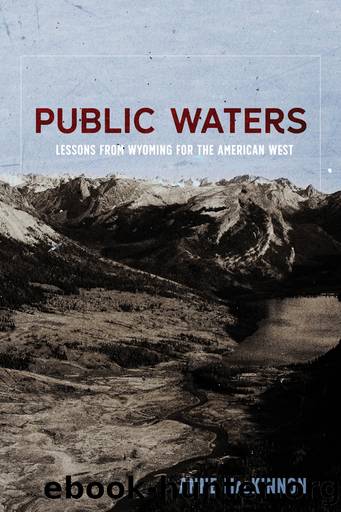Public Waters by Anne MacKinnon

Author:Anne MacKinnon [MacKinnon, Anne]
Language: eng
Format: epub, mobi
ISBN: 9780826362421
Publisher: University of New Mexico Press
Published: 2021-09-15T00:00:00+00:00
Meanwhile, the role of the state engineer in Wyoming water management had been changing, in response to a variety of pressures.
In the mid-1990s, anxiety gripped Wyoming and reached the State Engineerâs Office. It was worry over limited prospects, fear that Wyoming would again see the kind of subsistence incomes and strapped state budgets that characterized Wyoming for most of its history. State income had become dependent on revenues from coal, oil, and natural gas, but as their market prices dropped and oil production declined, it was the end of the halcyon days of the 1970s and early 1980s, when mineral money poured into state coffers, including into water development funds. At the end of the 1990s, state officials forecast a budget deficit, and a blue-ribbon committee dared to recommend that Wyoming adopt an income tax for the first time. State income tax was anathema to Wyoming residents long used to mineral bounty.7
In the late 1990s, however, a new kind of mineral production arose that promised the kind of revenue that would save the state from seriously contemplating that step. Natural gas (methane) can be found trapped in coal seams, and a couple of laid-off oil company staffers developed a reliable and cheap way of producing itâgetting enough gas from the seventy-foot thick coal seams in the Powder River basin in northeast Wyoming to make a good profit. Someone with just a water-well drilling setup could get down into unmined coal seams to get methane. By 1997, the volume of âcoalbed methaneâ (CBM) being produced in the Powder River basin appeared to be on its way to doubling in the next year. And when final figures came in, it had done better than that.8
There were water issues associated with this minerals boom. Coal seams in the Powder River basin are aquifers, and it is water pressure that keeps the methane in the coal; to get methane out of the coal, the water must be pumped out first. From the thick coal seams in the Powder River basin, that can mean a lot of water. In 1997, Jeff Fassett, state engineer during the most contentious years of adjudicating the tribesâ rights on the Wind-Big Horn River, was still in office, and he had a decision to make on CBM. Typically, the State Engineerâs Office does not supervise oil and gas operation production of water; itâs often in small amounts, sometimes used nearby. But as CBM and its water production grew, with potential impact on groundwater supplies, Fassett decided that pumping groundwater in order to produce CBM should come under State Engineerâs Office supervision. To do that, he ruled that pumping groundwater for CBM should be considered a beneficial use of water. Some people objected to the idea that simply pumping water up to get at another resource could be considered a beneficial use of the water itself. But the alternative appeared to be letting the state agency that managed oil and gas production be the sole authority in questions of the groundwater impacts of CBM production.
Download
This site does not store any files on its server. We only index and link to content provided by other sites. Please contact the content providers to delete copyright contents if any and email us, we'll remove relevant links or contents immediately.
Whiskies Galore by Ian Buxton(41937)
Introduction to Aircraft Design (Cambridge Aerospace Series) by John P. Fielding(33090)
Small Unmanned Fixed-wing Aircraft Design by Andrew J. Keane Andras Sobester James P. Scanlan & András Sóbester & James P. Scanlan(32763)
Craft Beer for the Homebrewer by Michael Agnew(18194)
Turbulence by E. J. Noyes(7977)
The Complete Stick Figure Physics Tutorials by Allen Sarah(7336)
Kaplan MCAT General Chemistry Review by Kaplan(6899)
The Thirst by Nesbo Jo(6877)
Bad Blood by John Carreyrou(6581)
Modelling of Convective Heat and Mass Transfer in Rotating Flows by Igor V. Shevchuk(6406)
Learning SQL by Alan Beaulieu(6237)
Weapons of Math Destruction by Cathy O'Neil(6213)
Man-made Catastrophes and Risk Information Concealment by Dmitry Chernov & Didier Sornette(5951)
Digital Minimalism by Cal Newport;(5700)
Life 3.0: Being Human in the Age of Artificial Intelligence by Tegmark Max(5509)
iGen by Jean M. Twenge(5384)
Secrets of Antigravity Propulsion: Tesla, UFOs, and Classified Aerospace Technology by Ph.D. Paul A. Laviolette(5332)
Design of Trajectory Optimization Approach for Space Maneuver Vehicle Skip Entry Problems by Runqi Chai & Al Savvaris & Antonios Tsourdos & Senchun Chai(5037)
Pale Blue Dot by Carl Sagan(4950)
